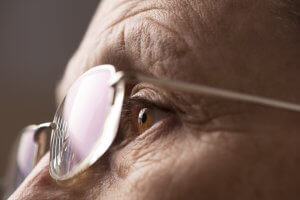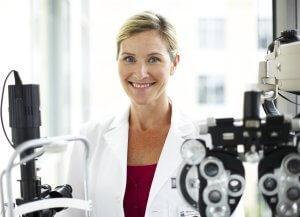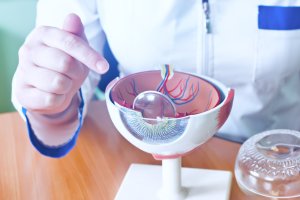Macular Degeneration FAQ’s

Voted Best of Berks—
eight years in a row!
Main Source: The National Institutes of Health
1. What is age-related macular degeneration?
Age-related macular degeneration, or AMD, is a disease that blurs the sharp, central vision you need for straight-ahead activities such as reading, sewing, and driving. AMD affects the macula, the part of the eye that allows you to see fine detail. AMD causes no pain.
2. Are there different forms of AMD?
Yes. AMD occurs in two forms — wet and dry.
3. What is wet AMD?
Wet AMD occurs when abnormal blood vessels behind the retina start to grow under the macula. With wet AMD, loss of central vision can occur quickly. Wet AMD is considered to be advanced AMD and is usually more severe than the dry form.
4. What is dry AMD?
Dry AMD occurs when the light-sensitive cells in the macula slowly break down, gradually blurring central vision in the affected eye. As dry AMD gets worse, you may see a blurred spot in the center of your vision. Over time, as less of the macula functions, central vision in the affected eye can be lost.
If you have vision loss from dry AMD in one eye only, you may not notice any changes in your overall vision.
With the other eye seeing clearly, you can still drive, read, and see fine details. You may notice changes in your vision only if AMD affects both eyes. If you experience blurry vision, see an eye care professional for a comprehensive dilated eye exam as soon as possible.
5. What are the stages of dry AMD?
Dry AMD has three stages — early AMD, intermediate AMD, and advanced dry AMD. All of these may occur in one or both eyes.
People with early dry AMD have either several small drusen or a few medium-sized drusen. Drusen are yellow deposits under the retina, which often are found in people over age 50. People with early AMD have no symptoms and no vision loss.
People with intermediate dry AMD have either many medium-sized drusen or one or more large drusen. Some people see a blurred spot in the center of their vision. More light may be needed for reading and other tasks.
In addition to drusen, people with advanced dry AMD have a breakdown of light-sensitive cells and supporting tissue in the macula. This breakdown can cause a blurred spot in the center of your vision.
Over time, the blurred spot may get bigger and darker, taking more of your central vision. You may have difficulty reading or recognizing faces until they are very close to you.
6. What are drusen?
Drusen are yellow deposits under the retina. They often are found in people over age 50. Your eye care professional can detect drusen during a comprehensive dilated eye exam.
7. Do drusen cause vision loss in advanced dry AMD?
Drusen alone do not usually cause vision loss. In fact, scientists are unclear about the connection between drusen and AMD. They do know that an increase in the size or number of drusen raises a person’s risk of developing either advanced dry AMD or wet AMD. These changes can cause serious vision loss.
8. The dry form of AMD has early and intermediate stages. Does the wet form have similar stages?
No. The wet form is considered advanced AMD.
9. Can advanced AMD be either the dry form or the wet form?
Yes. Both the wet form and the advanced dry form are considered advanced AMD. Vision loss occurs with either form. In most cases, only advanced AMD can cause vision loss.
10. Can the dry form turn into the wet form?
Yes. All people who have the wet form had the dry form first. The dry form can advance and cause vision loss without turning into the wet form. The dry form also can suddenly turn into the wet form, even during early stage AMD. There is no way to tell if or when the dry form will turn into the wet form.
11. What are the symptoms of wet AMD?
An early symptom of wet AMD is that straight lines appear wavy. If you notice this condition or other changes to your vision, contact your eye care professional at once. You need a comprehensive dilated eye exam.
12. What are the symptoms of dry AMD?
The most common symptom of dry AMD is slightly blurred vision. You may have difficulty recognizing faces. You may need more light for reading and other tasks. Dry AMD generally affects both eyes, but vision can be lost in one eye while the other eye seems unaffected.
13. Who is at risk for AMD?
AMD is most common in older people, but it can occur during middle age. The risk increases with age. Other risk factors include smoking, obesity, white race, family history of AMD, and female gender.
14. How is AMD detected?
AMD is detected during a comprehensive eye exam that includes a visual acuity test and dilated eye exam.
The visual acuity test is an eye chart test that measures how well you see at various distances.
In the dilated eye exam, drops are placed in your eyes to widen, or dilate, the pupils. Your eye care professional uses a special magnifying lens to examine your retina and optic nerve for signs of AMD and other eye problems. After the exam, your close-up vision may remain blurred for several hours.
15. How is dry AMD treated?
Once dry AMD reaches the advanced stage, no form of treatment can prevent vision loss. However, treatment can delay and possibly prevent intermediate AMD from progressing to the advanced stage, in which vision loss occurs.
16. What is the AREDS formulation?
The AREDS formulation is a combination of antioxidants and zinc that is named for a study conducted by The National Eye Institute called the Age-Related Eye Disease Study, or AREDS. This study found that taking a specific high-dose formulation of antioxidants and zinc significantly reduced the risk of advanced AMD and its associated vision loss. Slowing AMD’s progression from the intermediate stage to the advanced stage will save many people’s vision.
17. What is the dosage of the AREDS formulation?
The daily amounts used by the study researchers were 500 milligrams of vitamin C, 400 International Units of vitamin E, 15 milligrams of beta-carotene, 80 milligrams of zinc as zinc oxide, and 2 milligrams of copper as cupric oxide. Copper was added to the AREDS formulation containing zinc to prevent copper deficiency anemia, a condition associated with high levels of zinc intake.
The follow up study, AREDS II, showed slightly better results. In this study the beta-carotene was eliminated and lutein 10 mg and Zeaxanthin 2 mg were added. Speak to your eye care professional to determine which is best for your situation.
18. Who should take the AREDS formulation?
People who are at high risk for developing advanced AMD should consider taking the formulation. You are at high risk for developing advanced AMD if you have either intermediate AMD in one or both eyes OR advanced AMD, dry or wet, in one eye but not the other eye.
Your eye care professional can tell you if you have AMD, its stage, and your risk for developing the advanced form. The AREDS formulation is not a cure for AMD. It will not restore vision already lost from the disease. However, it may delay the onset of advanced AMD. It may help people who are at high risk for developing advanced AMD keep their vision.
19. Can people with early stage AMD take the AREDS formulation to help prevent the disease from progressing to the intermediate stage?
There is no reason for those diagnosed with early stage AMD to take the AREDS formulation. The study did not find that the formulation helped those with early stage AMD.
If you have early stage AMD, a comprehensive dilated eye exam every year can help determine if the disease is progressing. If early stage AMD progresses to the intermediate stage, discuss taking the formulation with your doctor.
20. How is wet AMD treated?
Wet AMD can be treated with laser surgery, photodynamic therapy, and drugs that are injected into the eye. The injections are painless. None of these treatments is a cure for wet AMD. The disease and loss of vision may progress despite treatment.
21. What can I do if I already have lost some vision from AMD?
If you have lost some sight from AMD, ask your eye care professional about low vision services and devices that may help you make the most of your remaining vision.
Ask for a referral to a specialist in low vision. Many community organizations and agencies offer information about low vision counseling, training, and other special services for people with visual impairments.
Don’t be afraid to use your eyes for reading, watching TV, and other routine activities. Normal use of your eyes will not cause further damage to your vision.
22. What research is being done?
The National Eye Institute scientists are:
- studying the possibility of transplanting healthy cells into a diseased retina
- evaluating families with a history of AMD to understand genetic and hereditary factors that may cause the disease
- looking at certain anti-inflammatory treatments for the wet form of AMD.
This research should provide better ways to detect, treat, and prevent vision loss in people with AMD.
23. What can I do to protect my vision?
You should have a comprehensive dilated eye exam at least once a year. Your eye care professional can monitor your condition and check for other eye diseases. You may also be advised to take the AREDS supplementation.
During an eye exam, you may be asked to look at an Amsler grid. You will cover one eye and stare at a black dot in the center of the grid.
While staring at the dot, you may notice that the straight lines in the pattern appear wavy. You may notice that some of the lines are missing. These may be signs of AMD.
Because dry AMD can turn into wet AMD at any time, you should get an Amsler grid from your eye care professional. You could then use the grid every day to evaluate your vision for signs of wet AMD.
24. Can my lifestyle make a difference?
Your lifestyle can play a role in reducing your risk of developing AMD.
- Eat a healthy diet high in green leafy vegetables and fish.
- Don’t smoke.
- Maintain normal blood pressure.
- Watch your weight.
- Exercise.
Find a Doctor
Physician information including education, training, practice location and more.
Schedule an Appointment
Call 800-762-7132 or make an appointment online.





